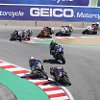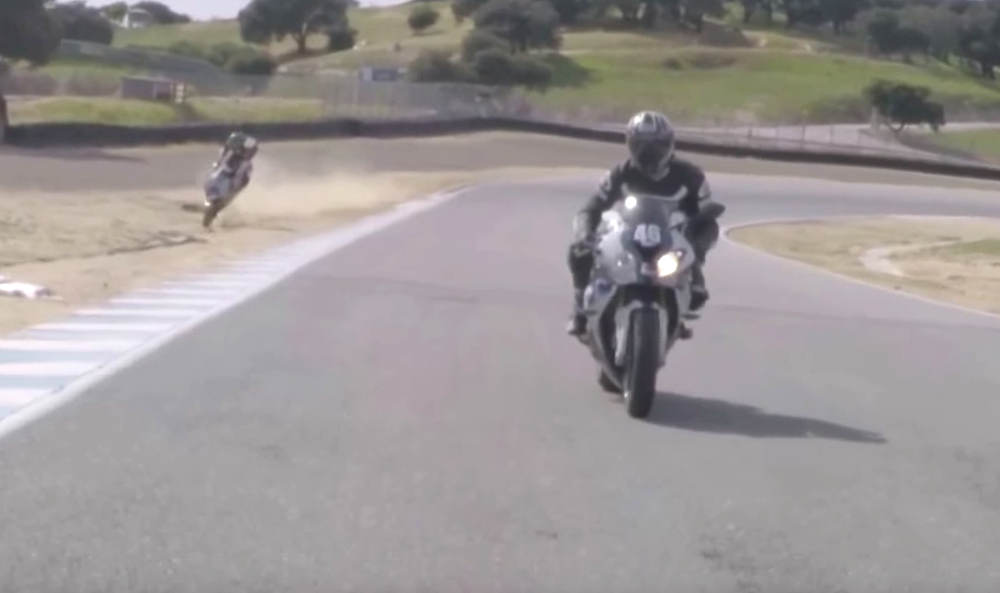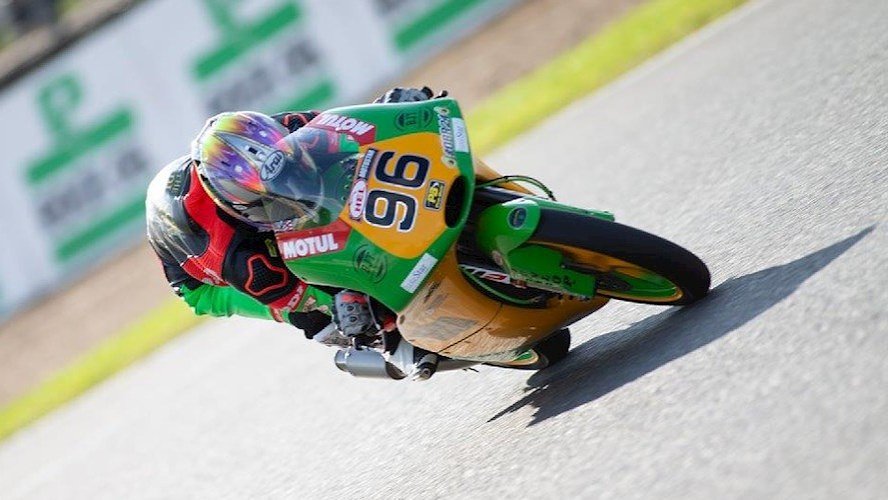Late last November, two announcements caused many motorcycle racing fans to wonder what the hell was going on at WeatherTech Raceway Laguna Seca.
The first announcement was that Monterey County had effectively — some might say, belatedly — fired the Sports Car Racing Association of the Monterey Peninsula. The non-profit corporation, better known by its acronym, SCRAMP, had managed Laguna Seca for more than 60 years, ever since the track was built on a disused part of Fort Ord in 1957. In 1974, the federal government deeded the land to Monterey County. The county effectively became the track’s new landlord and it relied on SCRAMP to manage the track. SCRAMP did so, until late last year, employing a professional staff of about 25 and deploying hundreds of volunteers for major events.
That all changed on November 19, when the Monterey County Board of Supervisors voted to turn the administration of the legendary track over to a company owned by — and employing — a single person named John Narigi. Narigi is a politically connected ex-hotelier with no prior experience in motorsport. His company, A&D Narigi Consulting, LLC, had at that point been in existence for less than two months.
Just days after Monterey County turned the track over to Narigi, Dorna released the 2020 Superbike World Championship calendar, which included no U.S. round. I wasn't the first to wonder, “Is Laguna Seca getting out of the racing business?”
A change of management that looks like cronyism
Laguna Seca is one of the best known race tracks in the United States, especially in the motorcycle world, where it has hosted grand prix, World Superbike and AMA Superbike races for decades (not to mention IndyCar and other races), but you don’t have to be paranoid to wonder if it could be endangered. The track’s been financially stressed since the Great Recession of 2008 and California real estate being what it is, Monterey County could earn many millions by developing even a portion of the area currently devoted to the circuit.
When I first started researching this story, a former SCRAMP official pointed me toward articles written in "Racer" magazine by Marshall Pruett. I suggest you read Pruett’s reporting on Monterey County’s decision to hand the Laguna Seca management contract to a company with no evident experience, staff, or credibility in the world of motorsport. If you’re in a hurry, however, here are some highlights:
- Narigi has made significant campaign contributions to three of the five members of the Board of Supervisors — the same people who voted to hand him control of Laguna Seca and pay him almost $230,000 per year to run it for at least the next three years. Narigi is currently being investigated by the State of California’s Fair Political Practices Commission for suspicion of campaign money laundering.
- The "A&D" in the company name is a reference to Narigi’s two sons, Anthony and Dominick. Anthony was killed and Dominick was injured in a crash on a Laguna Seca service road when they were leaving the 2007 Red Bull U.S. Grand Prix. Narigi sued the track, alleging that the design of the roadway contributed to the accident. The suit was later dismissed at his request, and the file’s been destroyed.
- The county’s decision not to renew SCRAMP’s management contract is not, in itself, surprising. In the years after 2008, SCRAMP’s professional staff responded to tightening revenue by juggling creditors and delaying payments. At one point, payments due to the county (what amounted to the track’s "rent") were as much as 18 months late. And, Monterey County, as the ultimate owner of the facility, was on the hook for late payments to many other vendors who’d supplied goods and services to SCRAMP.
The relationship between SCRAMP and the County eventually became so fraught that it was investigated by a Monterey County Civil Grand Jury, which released a report in 2016. In fairness to SCRAMP, the grand jury blamed some of the problems on lax oversight by the county. But it also pointed out that beginning in 2012, Mazda’s $2.4 million sponsorship — money that had been specifically earmarked for capital improvements — had, in fact, been diverted for operating expenses. The jury concluded that "SCRAMP's organizational capabilities and precarious financial position" raised doubts about its ability to manage the track.
MotoGP organizer Dorna contributed to the financial problems by diluting the value of one of the track’s best attended events by allowing the Indianapolis Motor Speedway and the Circuit of the Americas to also host U.S. rounds. In 2014, Dorna raised its asking price for hosting the race by $800,000. SCRAMP made the difficult decision to give up its most prestigious motorcycle event, which had been the scene of such memorable races as Nicky Hayden's first MotoGP win.
By 2016, SCRAMP was insolvent. The County hired an investigative management consulting firm, Harvey M. Rose Associates, which found that SCRAMP’s financial practices were "unorthodox." In order to keep the track operating, the county essentially bought SCRAMP’s assets and then hired SCRAMP back to administer the business of Laguna Seca.
In January 2019, SCRAMP made a last-ditch effort to get ahead of ongoing controversy by hiring its own accounting consultant, Hayashi Wayland, to tell it where it had gone wrong. As reported by Monterey County Weekly, Hayashi Wayland’s report found “numerous financial reporting and accounting weaknesses,” and “non-compliance with required audit reporting.” More damning, it found “glaring deficiencies” in cash management. SCRAMP had a safe on site that, according its own bookkeeper, should have had more than $325,000 in it. That amount — far more than was needed for normal operations — raised a red flag for Hayashi Wayland. That was before they counted it and found that about $35,000 was missing.
There's more, but I think it’s already clear that Monterey County had legitimate reasons to be frustrated with SCRAMP. What’s less easy to understand is why the County used a local TV station, KION, to announce that it was open to proposals from other organizations instead of issuing a proper Request for Proposals. That announcement happened on October 15 and proposals had to be submitted in about a month. Curiously, John Narigi registered A&D Narigi Consulting, LLC several days before the announcement was made on KION. It looked as if he had insider knowledge. And by only making a local announcement, it looked as if the county didn’t want Narigi to have any competition.
SCRAMP submitted a proposal but the Board of Supervisors was probably more surprised to receive a remarkably well prepared proposal from a company called Laguna Seca Management, LLC. That company was hurriedly formed by Chris Pook, who has promoted the Long Beach Grand Prix for decades and built it into one of America’s highest-profile races. Pook assembled a crack team of experienced motorsport pros who were ready to hit the ground running and presented a detailed list of personnel and a strategic plan. (To read all three proposals, click on the "Attachment B" link you’ll find on this page.)
Pook now feels that the effort he put into his pitch was wasted because the fix was in for A&D Narigi Consulting, LLC to win the contract. According to the Voices of Monterey Bay web site, Pook filed another complaint with California’s Political Fair Practices Commission, alleging that the request for bids and public hearing were just a show and the board majority had already decided to give the contract to Narigi.
There’s no reason to think the controversy over the way the contract was awarded is going to die down any time soon.
That doesn't mean racing at Laguna Seca is doomed
When I finally spoke to "Racer" magazine’s Marshall Pruett, my first question was, “Is hiring Narigi — a racing neophyte — just an excuse to purposely run Laguna Seca into the ground, so the county can get out of the racing business and develop the land for another purpose?”
Pruett immediately disabused me of that notion.
“The idea that the county is doing this because it wants to eliminate motor racing on that property is stupid,” he said. The county could have done that when SCRAMP was dumped, he pointed out.
“Anyone who thinks that the county, instead, embarked on a complicated plan to purposely hire an incompetent manager in order to give themselves an excuse to shut the track down has been watching too much TV,” Pruett said.
That also rings true to MotoAmerica partner Chuck Aksland. MotoAmerica will return to Laguna Seca in July, even though it won’t be paired with World Superbikes, as it has been in the recent past. Aksland told me that MotoAmerica negotiated its date with the county itself, during the transition period between SCRAMP and A&D Narigi. If the county wanted to get out of racing, it would have had a perfect excuse to blow off MotoAmerica by saying, “Hey, we’re in the middle of changing management, call John Narigi in a few weeks.”
Though Pruett is pretty certain Monterey County intends for racing to continue, he’s far from certain that Narigi’s company can keep Laguna Seca viable.
“Do I have any reason to trust the process by which the new skipper of this ship was nominated?” he asked rhetorically. “And do I have any reason to think that the skipper they’ve hired is competent? Or will the skipper — and whoever he surrounds himself with to run the ship — just sink the damned thing?”
After speaking to Pruett, I was scheduled to have a phone call with John Narigi, but he couldn’t make it. I spoke instead to Barry Toepke, who had been SCRAMP’s director of communications and who had just been rehired by the new company. Toepke assured me that all the key management positions beneath Narigi were going to be filled by experienced SCRAMP employees.
“We sat down yesterday and started to put together a press release about the people who are here," he said. "There’s well over 100 years of track management experience.”
“Marshall said he (Narigi) doesn’t have any race experience and that’s true," Toepke added. "But he’s a businessman and this facility needs to be run as a business. He has experience turning companies around and making them profitable. John’s asking the right questions, and he’s brought back the people he needs to run the operation. Just in the short time I’ve been back, I can feel new enthusiasm here. We’re starting from a clean sheet of paper.”
The other key person I talked to is Assistant County Administrative Officer Dewayne Woods. Pruett said the changes at Laguna Seca are "all being done to his plan" and some commenters on auto racing forums have suggested he's the mastermind of a plot to crash Laguna Seca once and for all so that the county can profitably develop the property and satisfy surrounding landowners who resent the track’s noise and traffic. If all that's true, then he’s also a terrific actor. (You can read a transcript of my interview with Woods on my web site.)
As for Pruett’s criticism that John Narigi, the new CEO, knows nothing about motor racing, Woods argued that during major events, neither SCRAMP nor the county have ever had control over what happened on the track. That is up to the sanctioning body.
“When IndyCar comes to the track,” he told me, “everything between the fences is IndyCar, everything from the fence back is us. We do hospitality, tents, catering, concessions. The things that we are really in charge of are synonymous with running an event, not a race.”
It is true that when groups rent the track in between events, for things like track days or race schools, the track itself is managed by Laguna Seca staff. For motorcyclists — more so than auto enthusiasts — those employees make decisions that directly impact our safety. Both Woods and Toepke assured me that the same people who managed those aspects of the operation during the SCRAMP days have been rehired.
At the end of my call with Dewayne Woods, I asked him if there was anything more he cared to add.
“Two things I want to leave you with are: one, if we run the business in a sustainable way, it will be here for the community and the volunteers for decades to come. And two, all the speculation about the county not being interested in having the racetrack is totally unjustified. This is a big regional economic driver. The county, through SCRAMP, had an economic impact analysis done, and the track brings over $80 million into the county every year. We’re fully invested in its success.”
The conversation left me conflicted. I agree with Chris Pook — the selection process looked, and maybe was, rigged. Awarding the contract to Narigi could be payback for years of political fundraising. But what if Pook's group was rejected because the county had such a bad experience the last time it entrusted a $20 million business to a bunch of racing enthusiasts? What if the county just wanted to install a businessman they knew and trusted? After talking to Dewayne Woods, that seemed like an equally plausible explanation.
The future of Laguna Seca
So what does the future hold for Laguna Seca? (Hint: probably not a Superbike World Championship round.)
In an anodyne e-mail, WSBK Manager of Communication and Brand PR Benjamin Cobb said the series would like to have a presence in the United States, but during negotiations with Laguna Seca "both sides were unable to meet their desired objectives."
A WSBK insider who would prefer to remain anonymous told me Laguna Seca was behind on payments to WSBK series organizer Dorna for previous years, which is why the 2019 event was initially left off the schedule, and then restored when a planned South African round fell through. Plus, said my source, track facilities "are terrible" and traffic in and out of the facility is a problem for the crews, just as it is for fans.
“California is the biggest bike market in the U.S. and we need to have a presence there,” my source stated, "but most people in the World Superbike paddock think that if the series returns to the U.S. any time soon, it will be to Barber" Motorsports Park.
From Rainey Curve to the famous Corkscrew, there's a lot of motorcycle racing history at the track and, like MotoAmerica's Chuck Aksland, I’m pretty optimistic it will continue. I asked Aksland whether he expected MotoAmerica to race at Laguna Seca indefinitely.
“That’s a big word, but yes, our goal is to be there for a long time," he said. "Obviously, it will depend on support from the fans but it’s a great area to visit and with our ideas on creating a ‘motorcycle festival’ instead of just a race, there will be a lot of different elements to entertain fans."
That would be welcome, because Laguna Seca could use some good news.








